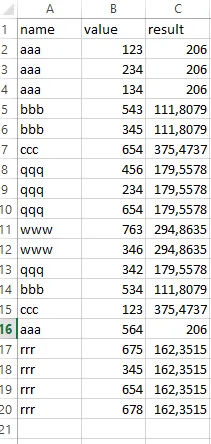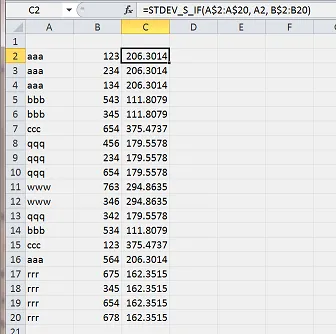我正在尝试编写一个Excel宏,以计算列A中相同文本的标准偏差,将来自列B的值引入并在列C中给出结果:

=STDEV.S(A2;A3;A4;A16)用于"aaa"。但是我需要自动完成此操作,因为我正在通过宏执行其他计算和程序。这是我的代码:Option Explicit
Sub Main()
CollectArray "A", "D"
DoSum "D", "E", "A", "B"
End Sub
' collect array from a specific column and print it to a new one without duplicates
' params:
' fromColumn - this is the column you need to remove duplicates from
' toColumn - this will reprint the array without the duplicates
Sub CollectArray(fromColumn As String, toColumn As String)
ReDim arr(0) As String
Dim i As Long
For i = 1 To Range(fromColumn & Rows.Count).End(xlUp).Row
arr(UBound(arr)) = Range(fromColumn & i)
ReDim Preserve arr(UBound(arr) + 1)
Next i
ReDim Preserve arr(UBound(arr) - 1)
RemoveDuplicate arr
Range(toColumn & "1:" & toColumn & Range(toColumn & Rows.Count).End(xlUp).Row).ClearContents
For i = LBound(arr) To UBound(arr)
Range(toColumn & i + 1) = arr(i)
Next i
End Sub
' sums up values from one column against the other column
' params:
' fromColumn - this is the column with string to match against
' toColumn - this is where the SUM will be printed to
' originalColumn - this is the original column including duplicate
' valueColumn - this is the column with the values to sum
Private Sub DoSum(fromColumn As String, toColumn As String, originalColumn As String, valueColumn As String)
Range(toColumn & "1:" & toColumn & Range(toColumn & Rows.Count).End(xlUp).Row).ClearContents
Dim i As Long
For i = 1 To Range(fromColumn & Rows.Count).End(xlUp).Row
Range(toColumn & i) = WorksheetFunction.SumIf(Range(originalColumn & ":" & originalColumn), Range(fromColumn & i), Range(valueColumn & ":" & valueColumn))
Next i
End Sub
Private Sub RemoveDuplicate(ByRef StringArray() As String)
Dim lowBound$, UpBound&, A&, B&, cur&, tempArray() As String
If (Not StringArray) = True Then Exit Sub
lowBound = LBound(StringArray): UpBound = UBound(StringArray)
ReDim tempArray(lowBound To UpBound)
cur = lowBound: tempArray(cur) = StringArray(lowBound)
For A = lowBound + 1 To UpBound
For B = lowBound To cur
If LenB(tempArray(B)) = LenB(StringArray(A)) Then
If InStrB(1, StringArray(A), tempArray(B), vbBinaryCompare) = 1 Then Exit For
End If
Next B
If B > cur Then cur = B
tempArray(cur) = StringArray(A)
Next A
ReDim Preserve tempArray(lowBound To cur): StringArray = tempArray
End Sub
希望有人能给我一个想法或解决方案。上述代码是用于计算相同文本值的总和。是否有办法修改我的代码以计算标准偏差?

